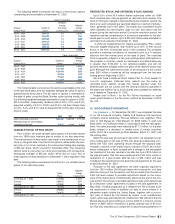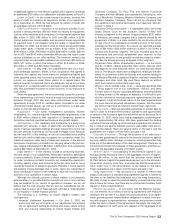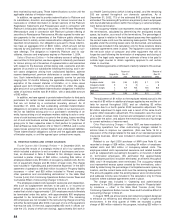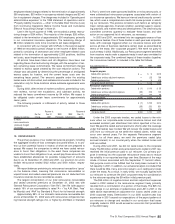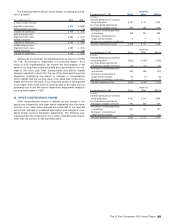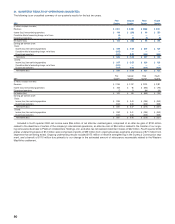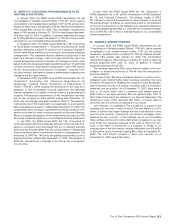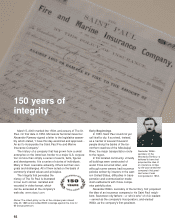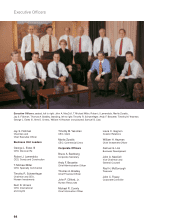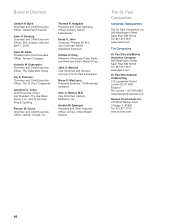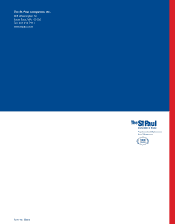Travelers 2002 Annual Report Download - page 93
Download and view the complete annual report
Please find page 93 of the 2002 Travelers annual report below. You can navigate through the pages in the report by either clicking on the pages listed below, or by using the keyword search tool below to find specific information within the annual report.
25. IMPACT OF ACCOUNTING PRONOUNCEMENTS TO BE
ADOPTED IN THE FUTURE
In January 2003, the FASB issued FASB Interpretation No. 46,
“Consolidation of Variable Interest Entities” (“FIN 46”), which requires
consolidation of all variable interest entities (“VIE”) by the primary ben-
eficiary, as these terms are defined in FIN 46, effective immediately for
VIEs created after January 31, 2003. The consolidation requirements
apply to VIEs existing on January 31, 2003 for reporting periods begin-
ning after June 15, 2003. In addition, it requires expanded disclosure
for all VIEs. We do not expect the adoption of FIN 46 to have a mate-
rial impact on our consolidated financial statements.
In December 2002, the FASB issued SFAS No. 148, “Accounting
for Stock-Based Compensation — Transition and Disclosure,” which
provides alternative methods of transition for a voluntary change to
the fair value based method of accounting for stock-based employee
compensation. This statement requires additional disclosures in the
event of a voluntary change. It also no longer permits the use of the
original prospective method of transition for changes to the fair value
based method for fiscal years beginning after December 15, 2003.We
currently account for stock-based compensation under APB Opinion
No. 25, “Accounting for Stock Issued to Employees”, using the intrin-
sic value method, and have not made a determination regarding any
change to the fair value method.
In November 2002, the FASB issued FASB Interpretation No. 45,
“Guarantor’s Accounting and Disclosure Requirements for
Guarantees, Including Indirect Guarantees of Indebtedness of
Others” (“FIN 45”), which expands the disclosures to be made by a
guarantor in the consolidated financial statements and generally
requires recognition of a liability for the fair value of a guarantee at its
inception.The disclosure requirements of this interpretation are effec-
tive for the company for fiscal periods ending after December 15,
2002, and, accordingly, have been included in Note 17.The measure-
ment provisions of this interpretation are applicable on a prospective
basis to guarantees issued or modified after December 31, 2002.This
interpretation does not apply to guarantees issued by insurance com-
panies accounted for under insurance-specific accounting literature.
We do not expect the adoption of the measurement provisions of FIN
45 to have a material impact on our consolidated financial statements.
In July 2002, the FASB issued SFAS No. 146, “Accounting for
Costs Associated with Exit or Disposal Activities,” which requires com-
panies to recognize costs associated with exit or disposal activities
when they are incurred rather than the current practice of recognizing
those costs at the date of a commitment to exit or a disposal plan.The
provisions of SFAS No. 146 are to be applied prospectively to exit or
disposal activities initiated after December 31, 2002. The adoption of
SFAS No. 146 will result in changes to the timing only of recognition
of such costs.
In April 2002, the FASB issued SFAS No. 145, “Rescission of
FASB Statements No. 4, 44, and 64, Amendment of FASB Statement
No. 13, and Technical Corrections.” The primary impact of SFAS
No. 145 was to rescind the requirement to report the gain or loss from
the extinguishment of debt as an extraordinary item on the statement
of income.The provisions of this Statement are generally effective for
fiscal years beginning after May 15, 2002.We do not expect the adop-
tion of SFAS No. 145 to have a material impact on our consolidated
financial statements.
26. VARIABLE INTEREST ENTITIES
In January 2003, the FASB issued FASB Interpretation No. 46,
“Consolidation of Variable Interest Entities” (“FIN 46”), which requires
consolidation of all variable interest entities (“VIE”) by the primary
beneficiary, as these terms are defined in FIN 46, effective immedi-
ately for VIEs created after January 31, 2003. The consolidation
requirements apply to VIEs existing on January 31, 2003 for reporting
periods beginning after June 15, 2003. In addition, it requires
expanded disclosure for all VIEs.
The following represents VIEs, which may be subject to the con-
solidation or disclosure provisions of FIN 46 once this interpretation
becomes effective:
Municipal Trusts: We have purchased interests in certain uncon-
solidated trusts holding highly rated municipal securities that were
formed for the purpose of enabling the company to more flexibly gen-
erate investment income in a manner consistent with our investment
objectives and tax position. As of December 31, 2002, there were a
total of 36 trusts, which held a combined total market value of
$445 million in municipal securities. We own approximately 100% of
28 of these trusts, which are reflected in our financial statements.The
remaining 8 trusts, which represent $84 million in market value of
securities, are not currently consolidated in our results.
Joint Ventures: Our subsidiary, Fire and Marine, is a party to five
separate joint ventures, in each of which Fire and Marine is a 50%
owner of various real estate holdings and does not exercise control
over the joint ventures, financed by non-recourse mortgage notes.
Because we own only 50% of the holdings, we do not consolidate
these entities and the joint venture debt does not appear on our bal-
ance sheet. Our maximum exposure under each of these joint ven-
tures, in the event of foreclosure of a property, is limited to our
carrying value in the joint venture, ranging individually from $8 million
to $29 million, and cumulatively totaling $62 million at December 31,
2002. The total assets included in these joint ventures as of
December 31, 2002 were $160 million.
The St. Paul Companies 2002 Annual Report 91


